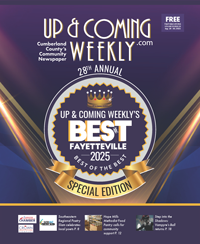- Details
-
Tuesday, 02 December 2025
-
Written by Margaret Dickson
Here is some excellent news about some of our highest-achieving high school students. The state Board of Education heard just how well they are doing earlier this month. A record number of high schoolers are both taking and passing Advanced Placement exams, with an increase of more than 7 percent taking the rigorous tests and a whopping 21 percent increase in their passing rate. In a state that has fallen behind in educational achievement and funding, it is notable that North Carolina’s passing rate on AP exams, 72 percent, is 2 points above the national average.
Passing AP exams gives students a good chance of being accepted to the schools of their choice, along with providing earned college credits.
Said the proud director of the Office of Advanced Learning and Gift Education, “It’s a clear reflection when students are given an opportunity, they rise.”
The good news is widespread.
This school year, nearly 100 thousand North Carolina students have signed up to take Advanced Placement courses, a 33 percent increase in a decade. That growth has come in all 8 state education regions, including Western North Carolina, where many students are still contending with damage from Hurricane Helene a year ago.
As always, though, legislative danger lurks.
The General Assembly has been unable to approve a budget and has threatened to cut funding for students to take AP exams, limiting who is able to take the exams.
What on earth are legislators thinking?!?!!?
More thoughts on the education front.
With the skyrocketing cost of higher education, many families have urged their students to take a direction track—a community college trade program, an apprenticeship of some sort, or taking a well-paying job straight out of high school.
Not everyone wants to or should go to college or pursue a university degree. That said, it is important to remember and to factor into any educational decision the reality that college graduates will earn significantly more money over their careers than high school graduates.
Social Security Administration research finds that a man with a college degree will earn $900,000 more than his high school graduate counterpart. The numbers are lower for women (what else is new?), but they show a similar discrepancy. A woman with a bachelor's degree will earn $630,000 more over her lifetime than her high school graduate friend.
Graduate degrees for both men and women make an even larger difference, with men earning $1.5 million and women earning $1.1 million more than high school graduates.
Food for thought and for long-term planning.
Anyone who has set foot in Cape Fear Valley Medical Center knows that Cumberland County residents are hardly the only people seeking health care there. It and its level 3 trauma center draw patients from all over southeastern North Carolina.
Its ER is ranked the 18th busiest in the nation, ahead of Massachusetts General in Boston.
A main driver of this is the ongoing demise of small hospitals in rural areas, including eastern North Carolina. Since 2005, 11 rural NC hospitals have closed or significantly curtailed services, making us 3rd in the nation in this sad statistic. Financial pressures from declining and low-income/unemployed populations, fewer medical personnel in rural areas, and dependence on low reimbursement government health insurance programs are fueling the decline.
The coming Methodist University Cape Fear Valley Health School of Medicine—whew!—is expected to ease the situation in our part of the state just as the Brody School of Medicine at East Carolina University has done in that region, but with the first class of medical students entering in 2026, it will be years before any of them hang out their shingles. Fingers crossed that many do so here and as soon as possible.
- Details
-
Tuesday, 02 December 2025
-
Written by John Hood

 North Carolina has one of the best-performing economies in the country. We also have one of the country’s most competitive tax codes. That’s no coincidence. Tax reform had served our state well.
North Carolina has one of the best-performing economies in the country. We also have one of the country’s most competitive tax codes. That’s no coincidence. Tax reform had served our state well.
According to a just-released study by the Tax Foundation, North Carolina’s overall tax system is the 13th-most competitive in the country and third-best in the southeast, after Florida (#5) and Tennessee (#8).
In all the major categories of taxation — individual income, corporate income, property, retail sales, and payroll (to fund unemployment insurance) — our state ranks in the top half by the Tax Foundation’s criteria of simplicity, neutrality, transparency, and growth-enhancement. We do particularly well in corporate taxes (3rd lowest) and payroll taxes (7th).
During the 1990s and 2000s, North Carolina fared poorly on most of these measures. To the extent our state competed effectively for people, businesses, and capital investment, it did so in spite of our tax system, not because of it.
Fiscal conservatives shouldn’t oversell the effects of tax policy. Many other factors influence economic decisions, and North Carolina has many attractive features and assets to offer prospective residents, entrepreneurs, and investors. All other things held equal, however, most empirical research on the question shows a negative association between high taxes and economic growth.
South Dakota, for example, has one of America’s lowest tax burdens. New York has its highest. Plenty of people would still rather live, work, or invest in New York than in South Dakota because of the former’s deeply developed markets, cultural amenities, and access to capital of all kinds. But South Dakota’s pro-growth tax code has helped it compete — and New York is leaking people and money to places such as Florida, Texas, and North Carolina that have assets South Dakota lacks as well as better tax systems.
“Taxes are not everything,” the Tax Foundation observes, “but they do matter, and they are within the control of policymakers. Even within a given revenue target, there are better and worse ways to raise revenue.”
In addition to the research it cites, I’ll mention a 2023 study in the Journal of Risk and Financial Management. Its authors examined 10 years of county-level data across the United States. They found that, to varying degrees, increases in income, sales, and property taxes are all associated with lower rates of employment, growth, and innovation (as measured by patents issued per resident). “The results consistently underline that taxes have detrimental effects on local economies,” they wrote, “whether urban or rural.”
Since 2011, the North Carolina General Assembly has broadened the base and lower the rates of both our personal-income tax and our sales tax. Lawmakers have also slashed our corporate-income tax by more than half and are on track to phase it out entirely by the end of the decade. By itself, the latter reform will likely vault North Carolina into the top 10 states in tax competitiveness.
Corporate taxes are especially pernicious and harmful because they warp capital flows and labor markets. Remember that corporations aren’t actually taxpayers. They are bundles of contracts among taxpayers. When corporate managers send money to state or federal treasuries to satisfy their companies’ income-tax liability, those funds must come from one of three places: 1) money otherwise paid to employees and vendors, 2) money otherwise paid to owners and shareholders, or 3) money collected from their customers as higher prices.
Studies show that the actual incidence of a hike in corporate tax is spread across all three groups, but not evenly. Consumers are often very responsive to price changes and can often buy products made in lower-tax jurisdictions. In the short run, shareholders may take the hit — but over time, managers reduce it by moving assets and establishments to lower-tax jurisdictions. That leaves the least-mobile group, workers, bearing most of the cost over time.
North Carolina can and should eliminate our corporate tax, taxing people’s consumed income transparently and proportionally through other means to fund truly necessary public services.
Editor’s note: John Hood is a John Locke Foundation board member. His books Mountain Folk, Forest Folk, and Water Folk combine epic fantasy with American history (FolkloreCycle.com).

 I have not seen funds allocated for repainting the traffic lines on our city’s streets and roads—particularly along the “Gold Coast” section of Raeford Road. In certain areas, the lines are nearly invisible. On rainy nights, this becomes a dangerous situation.
I have not seen funds allocated for repainting the traffic lines on our city’s streets and roads—particularly along the “Gold Coast” section of Raeford Road. In certain areas, the lines are nearly invisible. On rainy nights, this becomes a dangerous situation.
 How to resolve AdBlock issue?
How to resolve AdBlock issue? 










 Understandably, the Cumberland County Board of Elections should operate in a nonpartisan manner because it directly impacts election fairness and public trust. Recognizing the need for transparency, it is crucial to examine whether it has ever operated without partisan influence, especially when Democrats dominated statewide politics for over a century, from the General Assembly to 100 statewide counties.
Understandably, the Cumberland County Board of Elections should operate in a nonpartisan manner because it directly impacts election fairness and public trust. Recognizing the need for transparency, it is crucial to examine whether it has ever operated without partisan influence, especially when Democrats dominated statewide politics for over a century, from the General Assembly to 100 statewide counties.